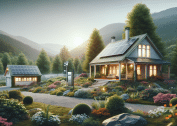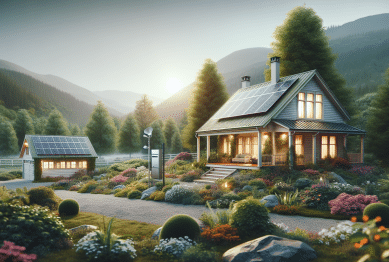Explore how you can transform your outdoor space into a tranquil backyard sanctuary that’s easy to care for. Learn key strategies for water-wise gardening, smart landscape design, and plant choices that maximize relaxation with minimal effort.
Understanding Low Maintenance Landscape Design
Low maintenance landscaping is more than just a trend; it’s a thoughtful way to create a beautiful, relaxing environment that requires less work over time. The core principle is to design your backyard sanctuary with minimal ongoing care in mind. This often involves selecting hardy plants, using mulch to suppress weeds, and reducing turfgrass areas. The result? A vibrant landscape that thrives with less input, freeing up more time for enjoyment rather than constant upkeep.
Choosing the right layout is essential. Grouping plants by water needs, sunlight requirements, and growth habits helps simplify irrigation and pruning. Incorporating hardscaping elements such as pavers or gravel pathways also reduces maintenance while adding useful outdoor living areas. Additional features, like stone benches or raised beds, can introduce architectural interest without requiring the maintenance that lawns often demand.
Designing with sustainability and ease in mind contributes to a more resilient, eco-friendly garden. Drought-tolerant species and native plants often require less water, fertilizer, and pest control. By understanding these design fundamentals, any outdoor enthusiast can create a welcoming backyard retreat that looks spectacular with only occasional attention.
Choosing the Right Low Maintenance Plants
Plant selection is a vital part of creating a successful low maintenance backyard sanctuary. Focusing on native shrubs, perennials, and groundcovers means less worry about pests, water demands, or frequent pruning. For instance, ornamental grasses, succulents, and drought-tolerant evergreens work well for a variety of regions and offer year-round visual interest with minimal care.
Many homeowners look for flowering perennials such as lavender, sedum, or coneflower because these don’t need to be replanted each year and often come back stronger with time. Mixing evergreen shrubs with these perennials ensures attractive color even during winter months. Smart plant choices like these build a vibrant landscape that largely looks after itself, helping achieve the goal of a truly easy-care backyard oasis.
Finding the right plants involves evaluating your climate, soil type, and the amount of sunlight your yard receives. Reputable local nurseries and gardening organizations can offer advice on optimal choices for your area. The resilience of well-chosen plants supports a home garden that feels lively and looks neat with minimal effort—and that’s what makes these selections an essential component of carefree outdoor living.
Smart Watering Solutions for Effortless Greenery
Efficient irrigation is a major part of any low maintenance backyard sanctuary. Drip irrigation systems and soaker hoses deliver moisture directly to plant roots, cutting evaporation loss and minimizing weeds. Smart timers further streamline watering, adjusting routines with local weather changes to help conserve water and reduce the gardener’s workload. These systems can be installed in both small and large outdoor spaces, bringing lushness without daily watering chores.
Mulching is a simple way to lock in soil moisture, suppress weed growth, and add a finished look to garden beds. Organic mulch materials—like bark, shredded leaves, or wood chips—gradually improve soil structure as they break down. Mulch acts as a low-tech ally in your backyard sanctuary, reducing the frequency and effort required for watering and weeding alike.
Incorporating drought-resistant turfgrass alternatives such as clover or buffalo grass can reduce water use even further. Pairing these grasses with xeriscaping—landscaping designed specifically for areas susceptible to drought—ensures your landscape remains green and inviting no matter the weather. Proper irrigation solutions are key to a garden that feels lush but rarely needs a hose.
Designing Relaxing Outdoor Living Spaces
A backyard sanctuary isn’t complete without a thoughtful outdoor living space. Comfortable seating, shaded patios, and simple garden structures like pergolas or arbors add function and charm. Choosing durable, weather-resistant materials for furniture and décor further reduces seasonal maintenance needs. These outdoor rooms are perfect for entertaining, quiet reflection, or a family meal under the stars.
Strategic placement of pathways and patios can create natural movement flow between entertaining zones, vegetable beds, and relaxation areas. Integrating solar-powered lighting extends enjoyment of the space into the evening and can help reduce electricity consumption. Design choices like these work together to shape a welcoming backyard that encourages relaxation and social connection.
Privacy is also a key consideration. Creating a sense of enclosure with fence panels, trellises, or living screens such as tall ornamental grasses or hedging plants can help your garden feel like a true hideaway. Blending these elements with the right plantings creates a retreat where you can unwind and recharge with little thought for upkeep.
Sustainable Practices for Easy Outdoor Upkeep
Sustainability in backyard gardening benefits both the environment and the gardener’s schedule. Composting yard waste and grass clippings reduces landfill overload and provides rich material to nourish garden soil. Opting for organic pest and weed management strategies further minimizes the need for chemical interventions. These small adjustments make a noticeable difference in maintenance demands.
Rainwater harvesting systems can supply supplemental water for irrigation, reducing dependency on municipal supplies. Even something as simple as using a rain barrel under a gutter can support container gardens or freshly established perennials. As a result, these eco-friendly systems save both water and money, making them a wise investment for effortless gardening in the long run.
Permaculture principles—like planting in polycultures or creating wildlife habitat with native plants—often lead to healthier gardens that largely take care of themselves. Encouraging pollinators with diverse blooms supports natural pest management. Embracing these ideas can lower inputs and resource needs while raising your enjoyment and sense of harmony with nature.
Seasonal Tips for Ongoing Low Maintenance Beauty
Smart seasonal routines keep your backyard sanctuary attractive all year long. In spring, clear away winter debris and check mulch levels; in summer, inspect irrigation for leaks and prune lightly to shape key shrubs. Autumn is the time to add compost or mulch and plant new perennials, while winter calls for little more than an occasional walk through the garden to spot any issues.
Grouping plants according to bloom time and foliage coloration creates visual interest through every season. Evergreen shrubs, ornamental berries, and textured barks offer winter color, while layering bulbs and long-flowering perennials enlivens beds from spring to fall. Such strategic planning gives your yard a cared-for look without the need for frequent replanting or rearranging.
Staying ahead of maintenance means fewer big projects down the line. Taking a few minutes each week to deadhead flowers or check for pests prevents work from piling up. With a little seasonal attention, you’ll find your sanctuary remains peaceful, manageable, and always inviting—no matter how busy you are.
References
1. National Gardening Association. (n.d.). Low-Maintenance Landscape Ideas. Retrieved from https://garden.org/learn/articles/view/3959/
2. University of California Agriculture and Natural Resources. (n.d.). Sustainable Landscaping. Retrieved from https://ucanr.edu/sites/scmg/Landscape_578/
3. Lady Bird Johnson Wildflower Center. (n.d.). Native Plants for Low Maintenance Landscapes. Retrieved from https://www.wildflower.org/learn/low-maintenance-landscapes
4. EPA. (n.d.). Water-Efficient Landscaping. Retrieved from https://www.epa.gov/watersense/water-efficient-landscaping
5. Cornell University Cooperative Extension. (n.d.). Gardening with Less Maintenance. Retrieved from http://gardening.cals.cornell.edu/landscaping/gardening-with-less-maintenance/
6. Sustainable Sites Initiative. (n.d.). Home Landscapes. Retrieved from https://www.sustainablesites.org/home-landscapes









